Landscape composition: depth
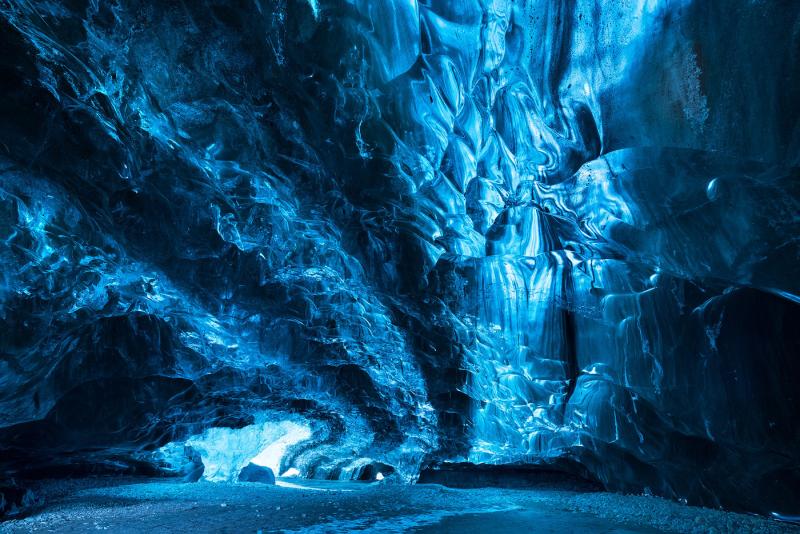
In my series of articles on landscape photography so far, I've talked about compositional elements , their weights, and how to use their properties to balance your composition by imagining a balance of pairs around an image's central axis. I also talked about the balance of negative space , the perception of the direction of the subject and the need to separate elements . It's time to finally (though perhaps only temporarily) leave the long discussion of balance and placement of elements and move on to another important aspect of landscape photography: depth.
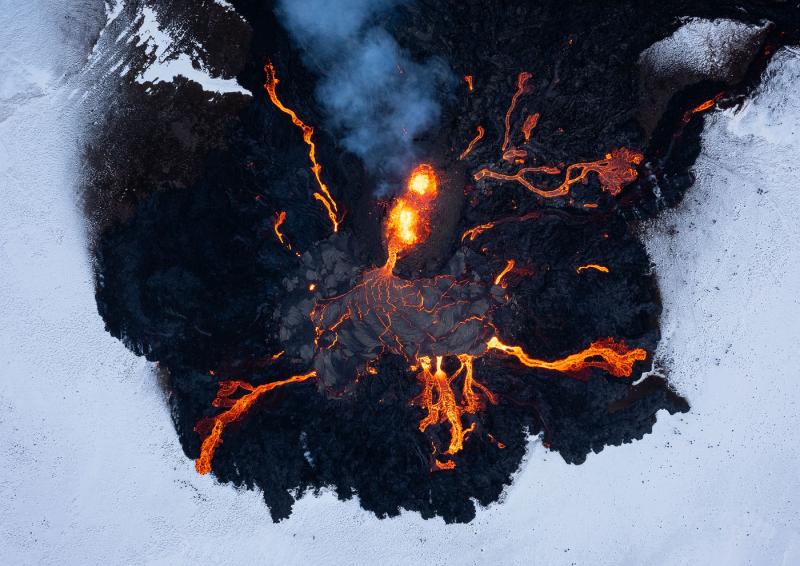 A top view of Fagradalsfjall volcano, Iceland. Does this image have depth to your perspective? If so, in what sense? If not, what would give it depth?
A top view of Fagradalsfjall volcano, Iceland. Does this image have depth to your perspective? If so, in what sense? If not, what would give it depth?
(DJI Mavic 2 Pro Viewpoint, April 2021 | 1/30 sec | F7.1)
Depth perception is of paramount importance in all areas of photography, as we have a two-dimensional medium that seeks to portray a three-dimensional reality. One of the worst definitions you can use for an image is to say that it's "flat" in some way, whether it's in color, contrast, or perceived depth. This is because we want to draw the viewer's eye into the photo and make them believe that what they are seeing is part of the world, not just a flat projection.
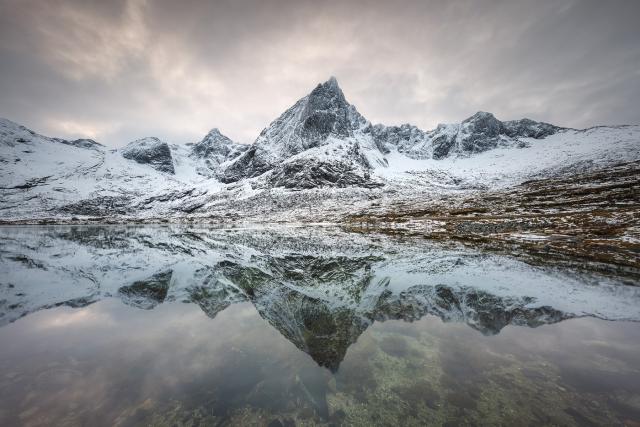 Same question as above.
Same question as above.
(Canon 5D IV, Canon 11-24mm F4 | ISO 100 | 0.5 second | F11)
In portrait photography, the photographer often creates depth by using a large aperture and blurring the background. This mimics the eye's limited depth of field and causes the brain to perceive the background as further away than the subject. In studio photography, a similar result is achieved by using studio lights in directions that emphasize depth, such as side lighting. But in landscape photography there are no controllable studio lights, and the oft-used wide-angle lenses won't blur the background even if we wanted to (and we usually don't). So how can we create a sense of depth in a landscape image? How does depth enrich landscape photography and how does this contribution compare to other fields of photography? Is depth always necessary?
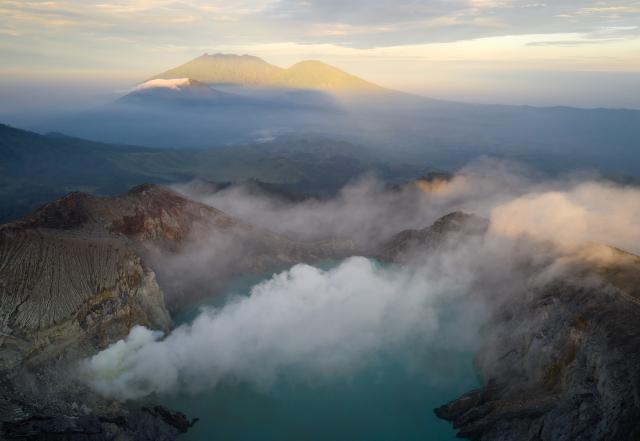 What is it about this image that enhances the sense of depth?
What is it about this image that enhances the sense of depth?
DJI Mavic II Pro | ISO 100 | 1/25 sec | F6.3
I'll answer the last question first: no, depth isn't always necessary. An image can be interesting and hold the viewer's attention in many ways. Take the image below for example, where there is virtually no depth. Even so, I like this image. It has movement, textures, lines, and interesting colors – all of which serve to make it attractive. It is also well balanced compositionally. (Can you use the concepts introduced in previous articles to explain how well this is balanced?)
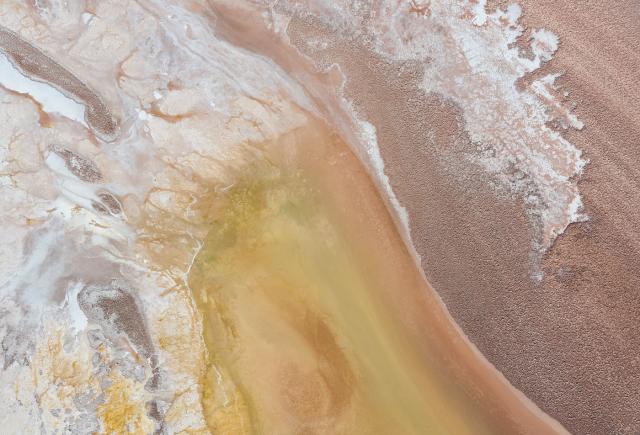
Let's go back to the original question: how do you create the perception of depth in a landscape image? For me the answer lies in a single notion: the relationships between compositional layers. Simple enough, but controlling that interaction is one of the most powerful ways to create interesting images that make viewers feel like they are part of the world being depicted. Let me explain exactly what I mean.
The most common way to create depth in an image is to include a near and far element. At the risk of being ridiculously obvious, I'd say that when there's a near element and a far element, the brain perceives the distance between them as the depth of the image. But this is a mystery in itself. How does the viewer know that the far element is far and the near element is near?
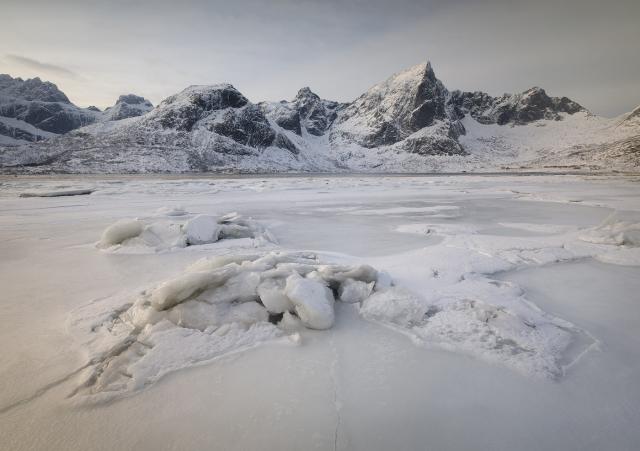 There's not much other than the intuition that suggests the mountains at the top of this image are further away than the pile of ice at the bottom. For all we know, the small mountains may be hovering right above the foreground ice.
There's not much other than the intuition that suggests the mountains at the top of this image are further away than the pile of ice at the bottom. For all we know, the small mountains may be hovering right above the foreground ice.
Canon 5D IV, Canon 16-35mm F2.8L III, focus stacked | ISO 100 | 0.4 seconds | F11
While knowledge of the usual size of mountains gives us an intuition that they are far away, this is not enough for a powerful image, I would argue. As photographers, it's best not to take this for granted. We would have to employ real methods of separating the different levels of distance to establish an adequate sense of depth in an image for the sake of the viewers. In this article, I will introduce three methods that we can use.
The first method, which brings us back to aprevious article , is to create a physical separation between layers of different distances. The simple logic is that if some compositional elements are separated from other clearly distinct elements, there must be some distance between them. Intuitive but not always implementable.
 The different dunes are separated from each other and from the mountain in the background by shadows and colors due to the different amount of snow on them. This reinforces the perception that the elements are distant from each other and, in turn, the feeling of depth in the image.
The different dunes are separated from each other and from the mountain in the background by shadows and colors due to the different amount of snow on them. This reinforces the perception that the elements are distant from each other and, in turn, the feeling of depth in the image.
DJI Mavic II Pro | ISO 100 | 1/60 sec | F8
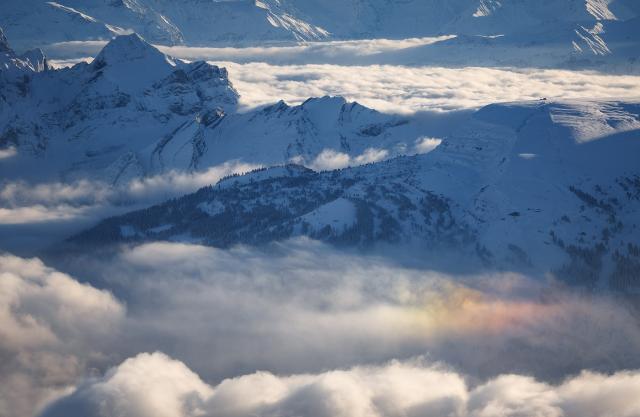 The multitude of distinct and separate layers enhances the feeling of depth.
The multitude of distinct and separate layers enhances the feeling of depth.
Canon 5D III, Canon 70-300 F4-5.6L IS | ISO 100 | 1/320 sec | F8
The second method of separating different levels of distance is to have some kind of qualitative difference between elements at different distances. This complements and reinforces the viewer's insights and enhances their understanding of what is happening in the image. Light might be the best differentiator: If items are lit differently, the brain tells us there's good reason to believe they're in different places, which probably means they're at different distances from the viewer. Again, I know this sounds a little (or very) obvious, but I still want to emphasize the important connection between the distinction of elements and the feeling of distance.
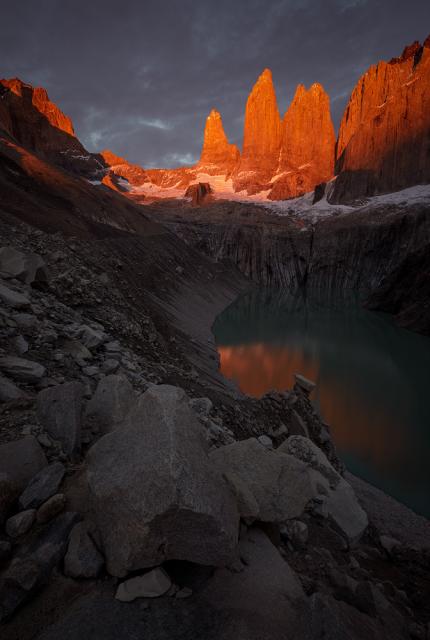 The mountains in the background (the Torres Del Paine) are lit radically differently from the elements in the foreground. This increases the perception that they are much further away than in the foreground, as in reality.
The mountains in the background (the Torres Del Paine) are lit radically differently from the elements in the foreground. This increases the perception that they are much further away than in the foreground, as in reality.
Canon 5D IV, Canon 16-35 F4L IS, focus stacked | ISO 100 | 1/2 sec | F14
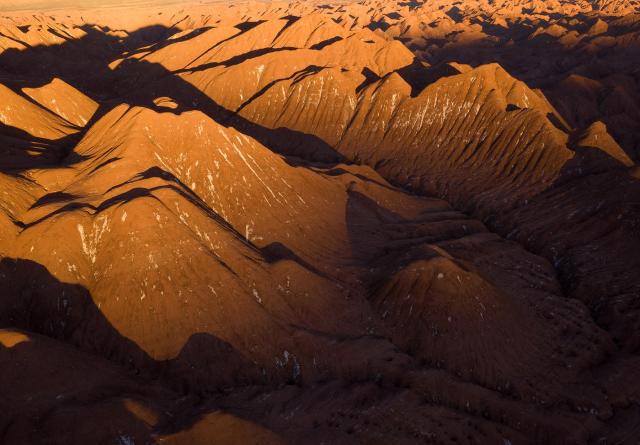 The gradient of light from bottom right to top left enhances the feeling of differentiation and depth.
The gradient of light from bottom right to top left enhances the feeling of differentiation and depth.
DJI Mavic II Pro | ISO 100 | 1/60 sec | F10
There may be other ways to differentiate elements to suggest different distances. For example, fog has a stronger effect the further away an element is, so if an element is more strongly engulfed, it is probably further away. This works in conjunction with the color differentiation created by the inherent fading of elements in the thickest fog.
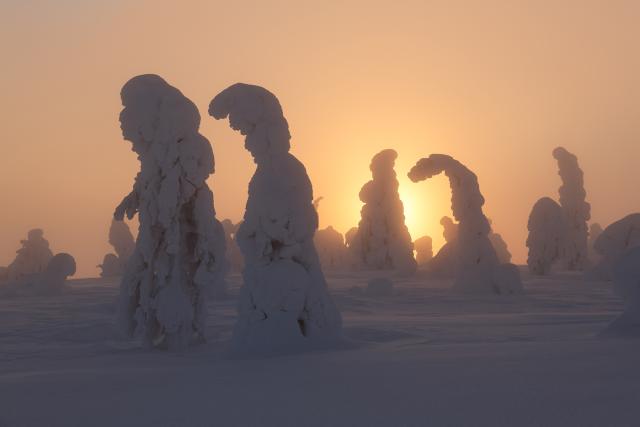 Elements further away are clearly blurrier, which creates a nice separation and improves the perception of depth in the image.
Elements further away are clearly blurrier, which creates a nice separation and improves the perception of depth in the image.
Canon 5D III, Tamron 24-70mm F2.8 | ISO 200 1/320sec | F8
The third method to differentiate levels of distance is to include an interaction between them. This can take the form of parallelism , but the best interaction comes in the form of guidelines . Guidelines are lines that guide the viewer's eye to and from different points in the image. These places may or may not contain compositional masses. Most commonly, guidelines lead from foreground to background, but that need not be the case: if there are lines leading the viewer's eye from one point to another, there must be some distance between them, and in our brain , that distance translates into depth.
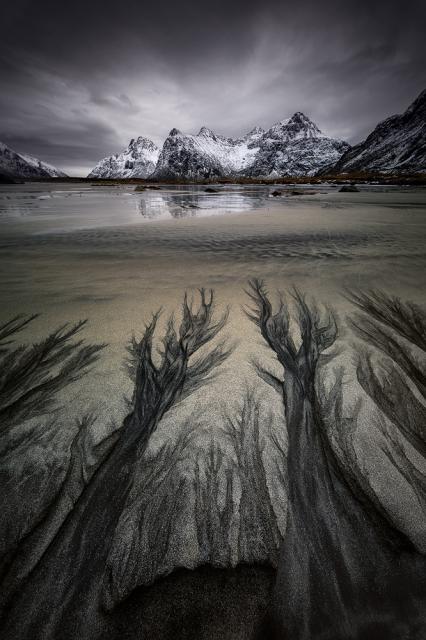 Here again the focus is on guidelines. These lines guide the viewer's eye from the obviously close foreground to the seemingly distant background. Also the fact that you can differentiate the grains of sand in the foreground improves the understanding that the foreground element is closer to you.
Here again the focus is on guidelines. These lines guide the viewer's eye from the obviously close foreground to the seemingly distant background. Also the fact that you can differentiate the grains of sand in the foreground improves the understanding that the foreground element is closer to you.
Canon 5D IV, Canon 11-24mm F4, focus stack | ISO100 | 0.8 seconds | F13
It is very important to keep in mind that the convergence of the main lines significantly increases the depth. As we all know, parallel lines appear to approach each other as they move away from us, so including a similar effect in a landscape image can help the viewer not only perceive depth, but also get a feel for it. of its greatness.
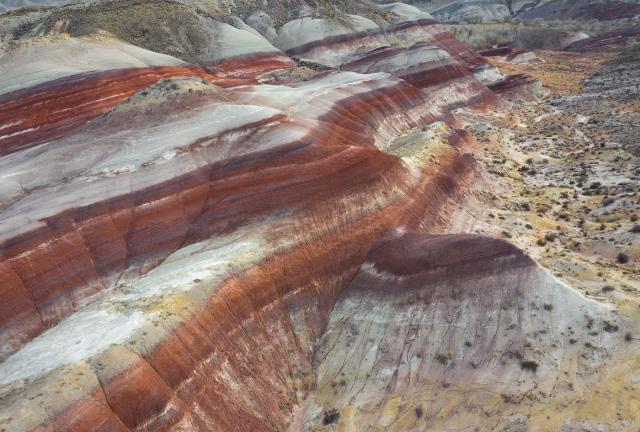 The red guidelines are more or less equally spaced in reality. The speed at which they converge helps the viewer judge the amount of depth in the shot.
The red guidelines are more or less equally spaced in reality. The speed at which they converge helps the viewer judge the amount of depth in the shot.
DJI Mavic II Pro | ISO 100 | 1/40 sec | F8
So far, the concepts I've presented in this article are by far the least contestable of the entire series. But here's a point you may not have thought about yet: Depth perception can be triggered by the above methods, even when there's no actual depth represented in the image. Let's go back to the first image presented in this article.

It may seem that this image must suffer from a lack of depth. After all, it's a top-down shot and everything is roughly the same distance from the viewer. But I would argue that even so, there is an apparent depth to this image.
The three methods I have examined are all very present here: differentiation between compositional layers – qualitative differences – interaction between layers. The three concentric layers (one could say four, see diagram below) - the eruption in the centre, the black earth and the snow on the periphery - are very well separated due to different colors and luminosities, while the multiple lava rivers connect the layers and create an interaction between them (interestingly, the main lines are radial, as opposed to the foreground-background type, but this makes sense since there is no foreground). All of this causes a flat top-down shot to have a feeling of depth despite the lack of it.
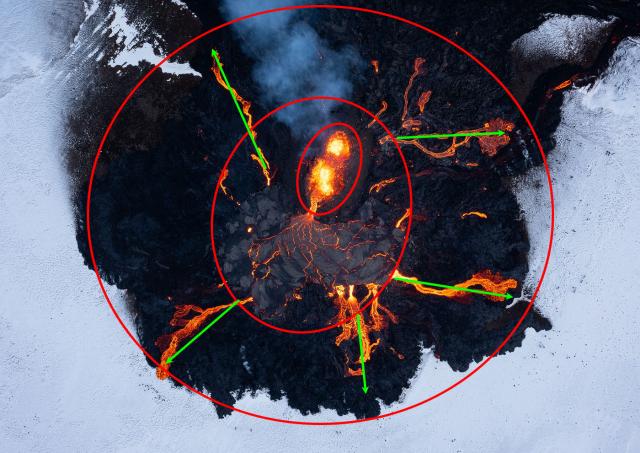 The different concentric layers in the image and the interaction between them.
The different concentric layers in the image and the interaction between them.
This is an extreme example, but so are other images. When the photographer wants to enhance the sense of depth in an image, the methods mentioned above can help him regardless of the actual depth. Let's look at some other examples:
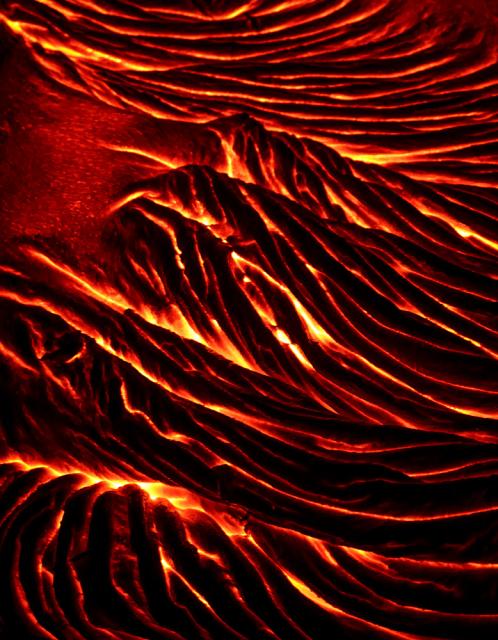
In the image above, the differences between masses and lines aren't significant, so we can't rely on foreshortening to show depth. However, there are distinct layers with different textures and those further away are blurred due to heat haze and shallow depth of field. This creates a sense of depth even when the difference in quality between image components is minimal.
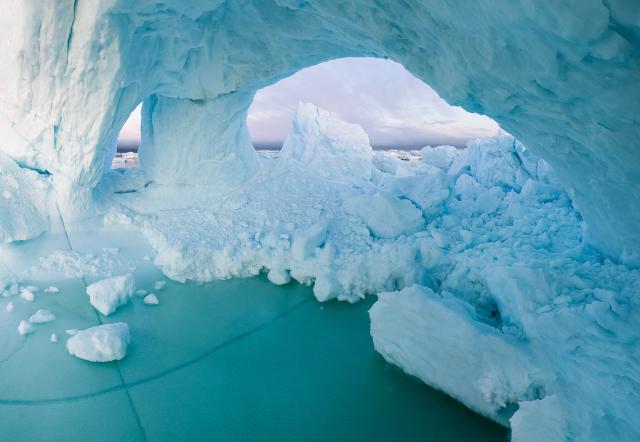
In the image above, the fact that the viewer is "surrounded" by the ice and looking out from the iceberg into the bay contributes to the sense of depth of the image. There's also a big difference in the brightness levels and colors of the different layers.
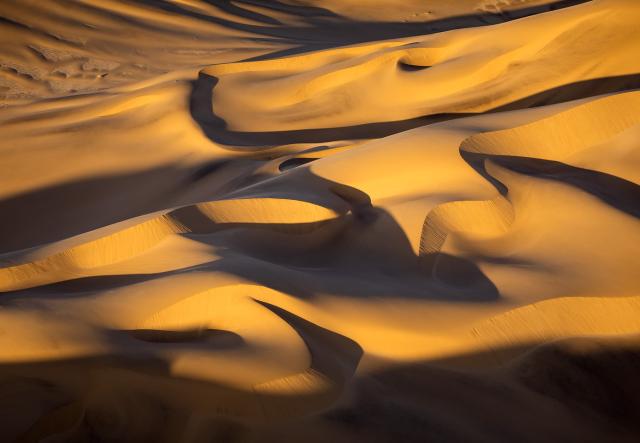
In this last example we don't have really distinct masses, and the lines are everywhere, but the separation of the layers by the late afternoon directional light serves to differentiate them and give a very pronounced sense of depth to the image.
When you subscribe to the blog, we will send you an e-mail when there are new updates on the site so you wouldn't miss them.
By accepting you will be accessing a service provided by a third-party external to https://www.insightadv.it/


































































Comments